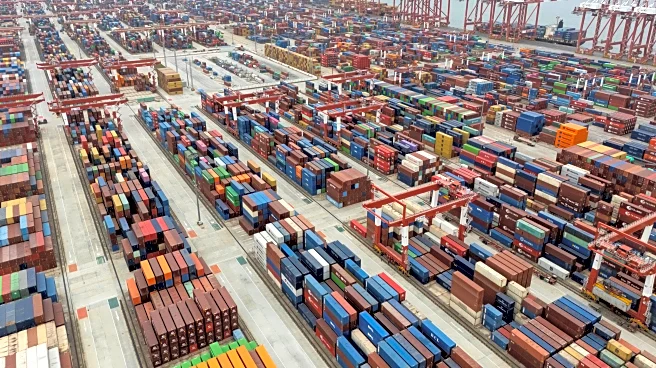What is the story about?
What's Happening?
Cargill has reported mixed results in U.S. soybean and corn export sales for the week ending September 4, 2025. According to the data, net weekly U.S. soybean export sales reached 48.1 million bushels, surpassing trade expectations of 14.5-37 million bushels. However, this figure includes only 19.9 million bushels in new sales, with a carryover of 28.2 million bushels from the previous year. Notably, China was absent from the export sales report, which is seen as a negative factor for soybean prices. Similarly, net U.S. corn export sales totaled 67.3 million bushels, aligning with trade expectations but showing a decrease from the previous week's 72.2 million bushels. The new sales accounted for only 21.7 million bushels, with a carryover of 46 million bushels from the previous year. This data is also perceived as negative for corn prices.
Why It's Important?
The export sales figures are crucial for understanding the current state of the U.S. agricultural market, particularly for soybeans and corn. The absence of China, a major buyer, from the soybean export report could signal potential challenges in international trade relations and impact U.S. farmers and exporters. The carryover in sales suggests a backlog that might affect future pricing and market stability. These developments could influence commodity prices, affecting the profitability of U.S. agricultural producers and potentially leading to adjustments in planting and production strategies. The market's response to these figures will be closely watched by stakeholders in the agricultural sector.
What's Next?
The USDA is expected to release the September World Agricultural Supply and Demand Estimates (WASDE) report, which will provide further insights into the agricultural market's outlook. Stakeholders anticipate tighter carryout figures for corn and soybeans, which could influence future pricing and market strategies. The report's findings may prompt reactions from agricultural producers, traders, and policymakers, potentially leading to shifts in export strategies and domestic production plans.
Beyond the Headlines
The mixed export sales data highlights broader issues in global agricultural trade, including the impact of geopolitical tensions and trade policies on U.S. exports. The absence of China from the soybean sales report may reflect ongoing trade disputes or shifts in China's sourcing strategies, which could have long-term implications for U.S. agricultural exports. Additionally, the carryover in sales underscores the challenges of managing supply chain logistics and market demand in a volatile global economy.
AI Generated Content
Do you find this article useful?















